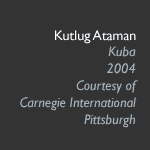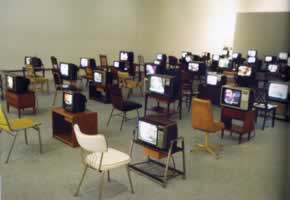


Manhattan’s New Museum of Contemporary Art is remaking itself from the ground up, aiming to become ‘a truly world class museum’ via its new building (opening in 2007) and recent curatorial appointments. Fresh from curating the 2004 Carnegie International, Laura Hoptman joined the museum’s staff this winter as a curator, bringing with her an ambitious, internationally oriented agenda. Merrily Kerr spoke to Hoptman about the New York art world, what she learned from the Carnegie International, and the New Museum’s new role.
MK - Will you bring your experience curating on an international level to the program at the Museum?
LH - With an important building under construction, a larger staff and a bigger budget, the New Museum is going to move to another dimension. I haven't joined the staff yet, so I don't know exactly what my parameters will be. But there is a gap in exhibition making here in New York City that can only be filled by a serious institution that concentrates on contemporary art. We have PS1, but it is a Kunsthalle, rather than a museum; of course, the big museums look at the contemporary, but not in the way that an institution that's devoted only to contemporary art can.
MK - Is the Museum's expansion part of a national trend of museum growth?
LH - Mid-sized institutions are creating a very important niche everywhere. The Hammer Museum in Los Angeles, for example, is the star institution for contemporary art in Los Angeles, the Whitechapel Art Gallery in London is giving the Tate a run for its money, and the Castello di Rivoli in Torino is the best contemporary exhibition venue in all of Italy, bar none.
Over the past fifteen years in New York, we have witnessed the demise of the not-for-profits which left the commercial galleries with the task of exposing new art and artists, by organizing idea-based exhibitions that addressed trenchant issues in culture and/or visual art in particular. Times are changing. There is a new kind of energy being generated in mid size institutions which concentrate on contemporary art. They are more flexible, faster on their feet than the larger museums and as a result, have a stake in leading the discourse. And that, after all, is the ideal goal of a contemporary art museum; not to reflect, but to act and to make something.
MK - Will you consider what other art is being shown in New York when planning the exhibition program?
LH - Absolutely. My first job in New York was at the Bronx Museum in the South Bronx. It was a real introduction to community based programming and, in a sense, I haven't changed at all even though I did curate the Carnegie International. By comparison, the Carnegie International and all big international exhibitions don't really have a local community. Pittsburgh wouldn't want a Pittsburgh oriented exhibition. So I was curating for an imaginary audience - the art world and the world at large. I found this particularly challenging and am happy to return to a more community based kind of programming, albeit in the savviest, most international art community in the world.
MK - You've said that 'every era gets the art it needs - or deserves.' Is there a new kind of art being made since you planned the International?
LH - I can speak with most authority on what I have observed in the U.S. Here, it seems that we're still in a moment of apocalyptic uncertainty. Two or three years after 9/11, people were still searching for the reaction, but the self-questioning really began before that, with the impeachment of Bill Clinton and subsequent election of George Bush. I think the country changed. The way this change has been reflected in contemporary culture I think is one of the most pressing and interesting questions of the moment.
With the last Carnegie International, I tried to explore, with the help of the thirty-seven artists that I worked with, an attitude toward art making that differed from a kind of frivolity that had been proliferating, especially in New York City, in the late 90s and early 2000s. That kind of ease in the world is losing its relevance, though it'll come back, I'm sure. It has been replaced by unease and desire to seize the power, whether it be in a spiritual or even supernatural sense, or through philosophy or even politics.
MK - Doesn't the legacy of Pop still hold sway?
LH - Yes and no. It's certainly not the only strategy for a relevant, politicized art. The last Whitney Biennial, quite wonderfully emphasized the Pop and post-Pop strain of contemporary art; the show was the polar opposite of the International, a fact that emphasizes the notion that there are many ways to define contemporanaeity. Whereas the Biennial was to me filled with art about our own backyard - racially, socio-economically and in other ways, the work in the International was about more macro issues like ethics, and spirituality. The International posited a different purpose for artmaking, a larger one I think.
MK - Reviews of the International were mixed. Were they fair?
LH - It is important to say at the outset that the Carnegie International hasn't gotten a positive review in the New York Times since the nineteen eighties, and that all massive group exhibitions of this kind are naturally magnets for creative art criticism. How easy a target is a show that claims to sum up an entire world of contemporary art from one point of view?
That said, the breakdown of good and bad reviews for this last show were telling. European and Canadian publications liked the exhibition; so did regional papers like Philadelphia and Cleveland. The problematic reviews mostly came from the American newspapers. I think that this proves that there is a big gulf between what's going on in the contemporary art worlds in Europe and American centers like New York; we have a very provincial streak here in New York, and what we look for in exhibitions might be different than what others look for. Our concern, or lack of concern, about some things is not necessarily translatable to Zagreb, or even to Berlin, and the universalist 'us and them' attitude that we can't help but have here in the center of the art market is one that is not necessarily right. That's why, to quote a friend of mine, I curate on the basis of need. I consider the needs of the people who are looking at an exhibition, as well as the needs of the artists, and most importantly, the needs of our time. That's the ultimate aim; to do the best one can for the time one lives in.